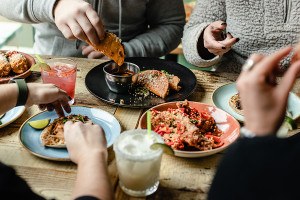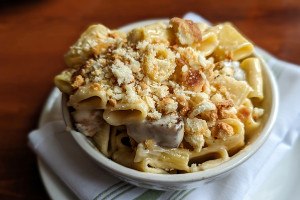Dining Out: Seeing Red
Rouge
480 Columbus Avenue
Boston
617-867-0600
Chefs: Salvatore Fristensky and Andy Husbands
Southern food is more than fried chicken, and New Orleans cuisine more than Cajun shrimp and blackened fish. Rouge, Andy Husbands's new restaurant in an appropriately red-hot South End location formerly occupied by Southend Galleria, is trying to show us Yankees a li'l somethin' about how folks do things down South. That the two boys doing the showing — Husbands and his chef, Sal Fristensky — grew up nowhere near the South gives them the zeal of converts.
Much of what they're serving gets it right, at least according to this northerner and frequent appreciative visitor to the South. We're mostly used to the export version of southern cuisines — caricatures like spicy fried chicken, fat-laced instant grits with no flavor, hotter-than-hell redfish — and to barbecue, something Bostonians curiously excel at, with a recent history of bold and successful local incursions into that sacred realm.
The master pioneer was Chris Schlesinger, true son (though not grandson) of the South. At East Coast Grill he turned an easygoing obsession into a career, traveling the country in a hand-rigged pigmobile to enter slow-roast competitions. One of his chief disciples was Andy Husbands, who had a good deal of his mentor's personal stamp: intellect combined with laid-back charm, an appetite for work plus an ability to kick back.
Husbands brought all of this to his own place, Tremont 647, which remains hot in every way: full of young people on the rise who nightly enjoy Caribbean-style food that I've always found admirably ambitious and carefully made, but too heavily spiced for my taste. Husbands nonetheless knows a main truth about southern cuisine: It's subtle, with a complete emphasis on fresh ingredients, particularly vegetables (even if they're cooked way longer than what's considered chic), and a constant struggle between sugar and spice.
When the Galleria space, a quick hop from Tremont 647, became available, Husbands teamed up with Fristensky. They had spent time together on the competitive pig trail, and Fristensky had worked separately in true southern redoubts like North Carolina and New Orleans — where he was a lead cook at Commander's Palace, one of the very few restaurant legends in that self-satisfied city that still insists on doing things from scratch using top-notch ingredients. The two turned the new restaurant's awkward two-room format into a sexy dark-red bar and a starchy white dining room. The effect is something like a bordello that's joined to a respectable boarding house.
Rouge might have been better off if Husbands and Fristensky had decided to focus on one of the two very different cuisines that still merge in northern minds: southern and New Orleans. But when the focus narrows, some of the dishes are exceptional. And I'm betraying my antipathy for heat by saying that the ones I like best are the southern ones. I do love bacon fat, molasses, salt in the right quantity, and a touch of chile — all of them apparent in the dishes with which Fristensky shows he can really get the southern thing right.
Any real southerner will tell you that God is in the side dishes: greens braised a long, long time with fatback and molasses; grits stirred by hand for hours until they're plushly soft and nurturing but retain a bit of corn bite from being milled on an honest grindstone; sweet potatoes with not too much sugar, so you can taste the natural sweet starchiness. And Rouge is side-dish heaven. Fristensky's stewed collards are a lesson in braising, simmered a long time with bacon fat, onions, apple cider vinegar, and a special southern molasses that has a light smokiness and none of the sulfur people dread. His spinach is miraculously fresh, and the $3 charge for each side dish can't possibly cover the labor of cleaning and trimming it all. The Brussels sprouts are improbably perfect, glazed in butter and homemade vegetable stock. The biscuits are huge, fluffy, freshly made, and served warm, split, and buttered — too greasy for my taste. But the grits will teach northerners why this is a universal side dish. They (I know, in the South “grits” is singular) brought near-tears of nostalgia to a guest who seldom finds anything to miss about his Nashville childhood.
Bad news out of the way: The fried chicken is a huge letdown, and the fried green tomatoes aren't much better. The “knife and fork” chicken ($16.50) is composed of boneless thigh and breast pieces, soaked in buttermilk and Louisiana hot sauce, Fristensky told me, then dredged in a spice-herb mixture and breaded with corn flour and white flour twice, the second time for a final deep-frying just before serving. The result, the one night (of two dinners) I tasted it, was a soggy, overspiced crust and moist but characterless meat; I'd much prefer bone-in pieces and a darker, thicker crust, perhaps with crunchier cornmeal rather than corn flour. Less a matter of taste is the breading on the fried green tomatoes ($9). Here there's no cornmeal at all, and the tomato slices were pinkish and dull, without the acid bite that makes this dish a classic. Fristensky chose to add a New England touch, Maine crabmeat and rémoulade sauce — too much with the good celery root slaw. But that slaw is fresh, tangy, and nicely spicy. And the black-eyed-pea and ham hock gravy under the chicken is positively worth the price of the whole plate.
There's ample good news. Soup of the new year is the sweet potato and smoked chile with orange blossom honey and bee pollen ($6). The matte southwestern orange gives no hint of the powerful charge of flavor from the chipotles, which still let the delicacy of the honey come through, along with the crunch and anise-hinted taste of the bee pollen (every chef's magic dust these days). It's a soup to live on, and certainly one to keep on the menu all year. I didn't mind at all the spice on the New Orleans BBQ shrimp ($9.50), which seemed a fine way to put some interest into the usually dull shrimp we get. Fristensky sticks with the beer, hot sauce, and butter that identify this as an uptown New Orleans dish, and serves the generous bowl — tempting blackened tails aloft — with garlic toasts made of homemade French bread. That's bland, puffy French bread, the kind you get in New Orleans, one of several breads homemade here, although this one isn't served in the bread basket. More real tastes of the South are the sweet, oily white bread and sweet, cakey whole-wheat loaf, each made daily, along with the sweet, cumin-spiked corn muffins. (These veer into southern-export food.)
The effort in the details is what's best about most of the main courses, which feature terrific homemade gravies (real South again) and good, soft vegetables (more South). The main ingredients are less successful, like the dull, slightly tough beef rib-eye ($22.50) and too-bland steamed cod ($19). Two main dishes work completely: lacquered pork shoulder ($17.50) and wild Virginian striped bass ($21). The pork shoulder is spiced with the subtlety missing from many of the other dishes, painted with Creole mustard and brown sugar, and braised for hours in duck fat until the meat falls apart. It's pure confit pleasure. The riesling-braised cabbage would be just the right choucroute-style counterpoint with less butter whipped in at the end. The bass is an expert treatment of the best wild fish we get, simply sautéed with just the right crust and soft flesh.
Ah, the fabulous tradition of southern desserts! You won't find it here, at least not yet, though there's nice pumpkin ice cream with an unmemorable spiced chocolate cake (all desserts are $7), and a Jim Beam and Harpoon root beer float that sounds like something a southern cook might well serve.
You'll find a friendly welcome here (no phony southern hospitality, just brisk northern efficiency) and sides to make you yearn to head South (as if the weather weren't enough). Rouge is the beginning of a great regional education in a town that thinks it knows its geography.


